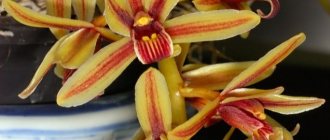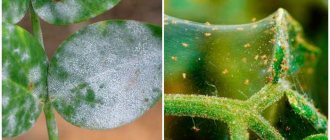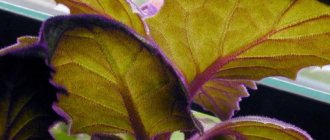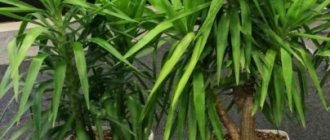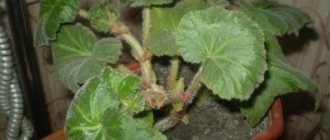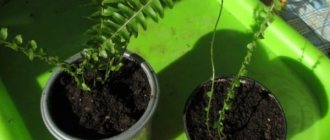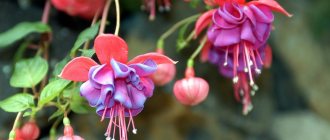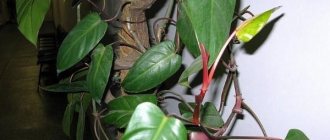Have you ever thought about how to grow banana at home? Consider growing an exotic plant such as a banana. This is a simple but unusual way to have lush foliage and a full supply of delicious fruit all year round. Instead of ordinary house plants, growing a banana will add freshness and greenery to your home, and of course positive emotions from its beauty and exoticism.
Banana trees are not often grown at home, despite the fact that we all love the fruits of this tree. By planting a banana tree, you can create a stunning, large and very chic tropical retreat in your home. With proper and good care, a banana will grow very quickly, beautifully and brightly filling a corner or window of your house. However, there is one drawback. Don't expect so much to actually harvest bananas. Unless you live in the tropics or have a large greenhouse, your plant may not have enough time and favorable conditions to flower and develop fruit. Instead, focus on growing banana plants for their beautiful and signature foliage, for the aesthetic pleasure of beholding a wonderful exotic plant.
What is a banana plant
Bananas are perennial plants and are considered herbaceous plants. Contrary to popular belief, their trunks are not wooden. Instead, their stem is created from layers of leaves wrapped around each other to form a trunk. Each banana plant grows from a bulb from which a true stem grows. The stem develops through the center of the stem, which subsequently produces fruit.
Each stem supplies a massive flower cluster that turns white. Another stem grows in its place. This process is repeated until the tree bears fruit, usually after one year of cultivating the new plant. To speed up the process, potassium-rich fertilizers are recommended.
The suckers (puppies) that grow at the base of the plant can be removed to propagate new plants. Once the plants have matured and produced fruit, it is important to leave at least one cutting in place as the mother plant may die.
What type of plant are bananas?
They do not grow on palm trees, but on herbaceous plants, the spherical fleshy roots of which are located deep underground. From the rhizome (rhizome) grows a succulent stem formed from leaf petioles (false stem).
Around the main stem, root shoots grow from the rhizome - shoots. The plants have huge leaves, the length of which reaches up to 2-4 m, and the width – up to 60 cm. Quite quickly growing leaves gradually die off. Their dried and hardened petioles form a false trunk of the plant.
If you look at a photo of a banana tree, you can see that the stems of the lower dead leaves have formed something like a trunk, and in the upper part there are green leaves. During this period, the plant really resembles a palm tree.
Under favorable growing conditions, one leaf appears within a week. When about 45 leaves grow and a real stem forms inside the false stem, the plant produces one huge peduncle. This happens approximately after 8 to 12 months.
White tubular flowers filled with nectar hang down in a multi-tiered cascade. The male ones, the smallest ones, are located in the upper part of the peduncle. In its middle part there are larger bisexual flowers, and in the lower part - the largest - female. It is from them that fruits are set after pollination.
The upper flowers, having fulfilled the function of pollination, fall off, and on the lower tiers of the peduncle further development, growth and ripening of the fruits occurs. The bunch consists of separate tiers. Several brushes grow in each tier. Depending on the variety and conditions there can be from 6 to 15 brushes.
The total height of the tree can reach 5-8, and in natural growing conditions even 15 meters.
At first, the fruits are light green in color. When ripe, depending on the variety, they gradually acquire shades of yellow or red. For the purpose of a longer period of storage and transportation, they are cut green. At this stage of maturity they are also not eaten by rodents.
The above-ground part of the fruit-bearing plant dies. The following year, a new stem grows from the oldest shoot of the rhizome and the plant repeats the same cycle of growth, flowering and fruiting. When growing bananas in agriculture, the strongest shoot is left the next year, and the rest is removed to avoid depletion of the land.
According to the cultivation technique, bananas are classified as berries.
With all the diversity of wild species (there are about 40 in total), plants growing in nature have oval, seed-filled, inedible fruits. The bananas grown as an agricultural crop that we buy for food are the result of the work of breeders. Such varieties do not exist in nature.
Some of the wild species live in nature for up to a hundred years. Intensive fruiting on industrial plantations lasts for ten to fifteen years, after which it is resumed.
Now you know how bananas grow. There are no fundamental differences in their growth, flowering and fruiting in the wild and in agriculture. There are significant differences in reproduction.
Which banana to grow at home
Most banana plants are sold as bulbs or corms. They can be special ordered or purchased from various suppliers online. When you receive your plants, rinsing them in warm water will ensure that any fungal deposits, debris and bacteria are removed before planting. This will ensure the plant is properly potted and established at its maturity.
When purchasing, the height of the plant usually determines the choice. Dwarf banana plants are suitable for apartments or cottages. Giant banana trees can be suitable for large homes with vaulted ceilings as long as all requirements are met, such as warmth, no drafts and plenty of sunlight.
Domestic banana trees typically grow anywhere from 1.5 to 3 meters and many varieties of banana are available nowadays.
The most common of them are the following types:
- Dwarf Cavendish
- Super Dwarf Cavendish
- Dwarf Lady's Finger
- Jamaican Dwarf
- Dwarf Brazilian
- William hybrid
- Grain Nain
- Rajapuri
- Musa Basju (does not produce fruit)
Conditions for growing bananas at home
- Light: Banana trees grow in full sun or light shade.
- During the growing season, banana palms need plenty of water. Water the plant generously and expect it to use more water as it grows. The plant will need to be watered daily.
- Temperature: These plants bloom at temperatures of 25 C and above. If you are maintaining the plant during the winter, try to keep the temperature as warm as possible, with a high humidity environment.
- Soil: Use a loose, well-drained, very nutrient-rich mixture.
- Fertilizer: Fertilize generously.
Banana diseases and pests
Before we talk about diseases and pests of indoor banana, let’s consider the most common difficulties faced by gardeners growing this plant:
- Banana growth has slowed down, its leaves wither and lose their shine. Reason: lack of nutrients. Solution: we carry out a series of planned fertilizing and “relocate” the plant into a larger pot.
- Indoor banana leaves dry out, wither and turn yellow. Reason: low air humidity. Solution: regularly spray the crown of the plant with water and raise the overall air humidity.
- Young leaves develop slowly. Reason: insufficient lighting. Solution: install artificial lamps.
- Banana foliage is too soft and drooping. Reason: air temperature too low. Solution: normalize the temperature (if necessary, you can use artificial heat sources).
- Dark pigmentation has appeared on older leaves. This is a completely normal occurrence and should not be a cause for concern.
Diseases
In room conditions, bananas practically do not get sick. In very rare cases, the plant is affected by anthracnose and viral mosaic.
Pests
Speaking of pests, indoor banana flowers attract spider mites, thrips and mealybugs.
Where to start planting bananas at home
Soil is one of the most important ingredients when growing banana at home. Bananas thrive in well-mixed soil with plenty of perlite and vermiculite. The soil should be light and with good drainage. Garden soil or potting mix for regular houseplants is too heavy and will hinder the plant's growth. For good drainage, you can add 20 percent perlite to the soil mixture.
The initial stages of banana plant development should begin in a standard medium-sized container with a drainage hole in the bottom to prevent water stagnation and provide proper ventilation for developing roots. Once a banana plant is planted, it will need a combination of bright light, warmth and high humidity for the leaves to begin to sprout.
Plant the rhizome vertically, leaving the top uncovered to allow light exposure. When a few new leaves appear, the corm can be completely covered with soil to promote better stability and additional root growth. Transplanting into a larger container will become necessary for the plant to bear fruit.
Features of caring for indoor bananas
Bananas are lovers of fresh air
In the warm months, when the night temperature does not fall below 18 degrees, indoor bananas grow well in the fresh air. They can be placed on the balcony or in the garden, in the shade.
But it is better to regularly ventilate them in the room, protecting them from drafts. Temperature changes are undesirable for this plant, and constant drafts have a detrimental effect on the development of the plant.
Temperature
Heat-loving and accustomed only to hot climates, indoor bananas prefer to grow in conditions in which even a drop to 16 degrees is not allowed.
Some domestic varieties are able to withstand temperatures of 10-12 degrees, but due to such endurance they lose their heat-loving properties. Thus, the very popular variety “Kyiv Dwarf” is best grown at 18-23 degrees Celsius.
But in general, all indoor bananas are resistant to heat. They grow well in summer even at temperatures above 25 degrees, and are not afraid of increases to 30 degrees and above.
The wintering temperature should be warm, stable, but not hot. It is best to keep bananas in autumn and winter at a temperature of 18 to 20 degrees Celsius.
Annual transplant
A banana grows well only when it has room to develop: if the rhizome has nowhere to grow, then the above-ground parts also stop growing. That is why bananas are grown in capacious, wide, spacious containers and with a thick layer of drainage sprinkled with sand on top. But the usual substrate will suit them - universal, loose and nutritious.
Usually this plant is replanted annually, but it can be replanted more often if the banana pleasantly surprises with its growth rate. Bananas are always carefully handled, preserving the earthen lump, but placing the plant lower, slightly deeper compared to the previous planting to stimulate the release of children and increase productivity.
For bananas to quickly adapt, just water them with warm water and place them in good light at mild temperatures. An important “trifle” is loosening the soil. It is carried out very carefully a few days after transplantation in order to aerate the old lump of earth.
Typically, an indoor banana is replanted annually, but it can be done more often if it pleasantly surprises with its growth rate. © laidbackgardener
Banana propagation at home
Banana trees are very easy to propagate due to their unique growth habit. The true banana "trunk" is a really large stem made up of old leaves that grow from the rhizome. In nature, each stem grows to maturity, flowers, bears fruit, and then dies. Meanwhile, the underground rhizome continuously sends up new shoots to keep the plant active.
In banana plantations, gardeners typically trim off additional stems as they emerge, so each rhizome will have only three stems at any given time: one immature stem, one flowering stem, and one fruiting stem. This ensures stable growth of bananas. So propagating bananas is a simple matter of digging up and dividing new stems as they appear, making sure they include some rhizomes and roots.
What kind of plant?
Banana is the tallest plant . It can reach 9 meters in height. The fruits grow in clusters - they can contain several hundred bananas. Depending on the variety, size, shape and color improve.
Most often they are characterized by a cylindrical shape. The peel can be tough and its color varies from green to brown. The pulp of the fruit can be white, yellow and orange. Cultivated banana species do not always contain seeds.
Bananas grow well in acidic soil, which has a maximum of minerals. On average, it takes 15 months to ripen, and the yield can be up to 400 centners per hectare. To increase shelf life, they are cut green .
This plant was cultivated a very long time ago. Asia and Malaysia are considered to be the homeland. Active spread began back in 650. In the northern regions, bananas became unavailable due to unsuitable climate. In many countries, this fruit is a staple food, so its consumption in some countries can reach 100 kg per person per year.
There are such groups:
- Dessert . They do not require heat treatment, and can be used in any form.
- Plantains . They need heat treatment. Their flesh is not sweet, but very hard. This group is often used as animal feed.
Watering a banana at home
Regularly watering the plant with enough water will retain moisture in the soil and reduce the chance of the bulb dying before it begins to grow. A delicate balance must be maintained, as overwatering can damage the plant just as much as underwatering. Because of its massive leaves, the banana plant needs a lot of water, but it should not be exposed to excessive amounts of moisture as this will lead to bacterial growth and plant root rot.
The soil should be allowed to dry out slightly between waterings and watered again as needed. To prevent premature evaporation, the top layer of soil can be covered with a layer of decorative mulch, bark or moss.
What are the indoor types with photos?
The main varieties include:
- Dwarf.
- Pygmy.
- Green.
- Red.
Dwarf
This plant grows well on a south-facing window . An adult banana may not fit on it, in which case it needs to be placed next to it. It is not planted in a large tub. Since the root system is quite large, the volume should be 20 liters.
Dwarf banana is a light-loving plant. It reaches towards the sun, so the pot needs to be rotated during short daylight hours. The tub should be on wheels or on a movable platform - this way it will be easier to rotate the plant.
The soil mixture will be suitable for flowering plants - it can be mixed with humus and sand. It would also be a good idea to add ash. The banana container must be deep .
Every 3 months, it is customary to replant a banana into a pot whose volume is one liter larger. Drainage is made at the bottom.
Note! Transplantation of sprouts can be done in summer or September. If you do this in cold weather, it may get sick and not take root at all.
Spraying the leaves daily is mandatory - in winter this is done 2 times a week.
Pygmy
Pygmy is a herbaceous plant whose rhizome can reach 2 meters. It is very effective for a greenhouse, winter garden and apartment . Banana leaves are large. They are characterized by a delicate texture. They are red at the bottom and can form a false stem.
Reference. This species is self-pollinating. The fruiting period occurs at 5 years of age.
Flowering occurs in the spring, and in summer the decorative fruits are very similar to small bananas. The above-ground part may die, and shoots often appear from the root, from which plant development occurs.
He loves warmth very much. It is very resistant to low air humidity. The most nutritious soil is considered to be turf soil made from sand and compost. In summer, the plant needs watering and feeding. In winter, watering can be moderate; in addition, the indoor plant needs weekly feeding.
Reproduction is carried out by suckers, seeds, rhizomes . Before planting, they need to be soaked for 24 hours. Sow seeds in sand and peat. The optimal temperature is 30 degrees. The soil should remain moist and there should be no stagnation of water.
Seed germination can take 10 weeks. Seedlings develop very quickly. In the summer, adult plants are planted in the garden in bright, wind-protected places.
Green
Special attention should be paid to green banana. It is removed from the tree before it ripens . Green bananas are often small in size - they look very attractive when bundled together. They are rightfully considered a natural source of an important substance. Potassium takes part in many segments of our body - it has a beneficial effect on the functioning of organs:
- Normalizes blood pressure and improves heart rhythm, protects against diseases of the cardiovascular system. It is an important assistant to the cardiologist as it prevents hypertension and angina pectoris.
- Calcium is the main component of the skeletal system. Its use fulfills the daily requirement. According to experts, you need to include this green fruit in your diet, as it can improve the condition of your hair and teeth.
- This product is very beneficial for the gastrointestinal system.
- Contains fatty acids. They are easily digested and promote the penetration of beneficial enzymes into the intestines.
- Banana pulp neutralizes stomach acid, and the active substances heal wounds.
- These fruits have a positive effect on the digestive system.
- Pectins stimulate the tract and normalize intestinal function. With diarrhea, a person can become dehydrated, and eating a banana will relieve this problem.
- Vitamin E has a positive effect on skin condition. It calms and protects against stress and anxiety.
- Sodium, which is part of the fruit, maintains water-salt balance. This factor plays an important role for the muscular system. This is especially important for people whose activities involve physical labor.
Red
Red ones are grown commercially . Large plantations take place in Costa Rica. Bananas are especially popular in this country. The fruits are often cut unripe and then transported all over the world. Afterwards they begin to ripen and acquire the desired taste.
Red bananas contain a lot of fiber, vitamins and salts. Therefore, they are not only tasty, but also healthy. One fruit contains 90 kcal, but some fruits have no fat at all.
Ripe fruits have a pleasant taste and aroma - they do not tolerate transportation well . Not everyone knows their taste. The most correct ones are those that ripen on the bushes. Red bananas can be eaten raw, smoked, dried and fried.
They are dried or used as a filling for baked goods. They often go well with oranges, pineapples, kiwis, peaches, and mangos.
What soil to use for banana plant.
Bananas will grow in almost any soil, but to ensure that you grow a healthy plant that produces delicious fruit, you must provide the ideal conditions for your plant.
The ideal soil you should use is loam-based compost. This is compost, which is a mixture of sand, silt or clay and organic matter.
Sandy loam compost is particularly good at absorbing water and moisture so it will stay moist
How to feed bananas at home
The banana plant can be watered and fertilized at the same time by mixing liquid fertilizer with the appropriate amount of water. Following the manufacturer's instructions usually produces the desired results and prevents excess chemicals that can damage the root system.
Fertilizer should be applied when the plant is about to reach maturity. During this time, the growing leaves will need an excess and constant supply of nutrients to result in a fruitful harvest. The simplest sign of a healthy banana plant is the continuous growth of flowers. This unusually means the plant is ready to produce fruit and needs constant nutrition.
During the growing season, I would recommend feeding your banana tree once a week.
Use a fertilizer that is high in potassium, magnesium and nitrogen as this will help stimulate the growth of your plant. You can use either liquid fertilizer or granular fertilizer, which will dissolve into the soil when you water it.
It is best to look for a fertilizer that is specifically for tropical plants. If you can't find it, then use a balanced fertilizer, which is 20-20-20.
During the fall and winter months, reduce the amount of fertilizer to only once a month.
Propagation of indoor bananas
Bananas are, without exaggeration, the easiest tropical indoor plants to propagate. The ease of obtaining offspring is the main reason for their affordable price. Indoor bananas produce babies in abundance, which, after being separated into small pots, quickly take root and begin to grow.
Vegetative propagation is much simpler than seed propagation, and you can’t collect the seeds yourself. But they are often found on sale, special indoor varieties. And if waiting for germination from 3 to 6 months does not scare you, then it is enough to soak the seeds for 12-24 hours (or until the shell softens) and carry out scarification.
The seeds are not sown, but pressed into light soil. Young plants are similar to adult bananas in everything, but they need to be replanted much more often.
Humidity and light when growing bananas at home
What should the humidity and light be like to grow a banana at home? The location on the south side of the apartment is ideal for banana plants. In nature, they thrive in indirect sunlight, partially blocked only by surrounding vegetation. Daily, 12-hour sun exposure combined with heat is the ultimate goal to bring the banana plant to its optimal health. If this is not possible, then 100 watt high intensity artificial light will replace natural light.
The plant should be rotated periodically to ensure that all sides of the plant are evenly exposed. It is also important to keep it in a draft-free area. Banana plants favor a calm environment and sudden temperature changes.
High humidity levels can be achieved by placing bowls of water around the plant. The vapor from the bowl will create enough moisture in the air to keep the plant evenly hydrated. The leaves require constant moisture to continue producing flowers and fruit.
What bananas can be grown at home in Russia and popular varieties
To get a compact ornamental plant that will produce a harvest, you need to choose special low-growing varieties for cultivation. To avoid disappointment, before purchasing a seedling, find out whether the selected variety is fruit-bearing, or whether its fruits are inedible and are grown solely for decorative purposes.
Each category of varieties has its own advantages. Fruit trees will delight you with a bountiful harvest; decorative ones, although they have inedible fruits, are more attractive in appearance.
Dwarf fruit
Among the fruit bananas for home cultivation, the following varieties are used:
- “Kiev dwarf” - grows up to two meters in indoor conditions. It produces up to 300 small (up to 15 cm long) dessert fruits per year. The variety is resistant to diseases and pests, tolerates low winter temperatures well, and can grow at +15°C without reducing yield.
- “Super dwarf” - when grown indoors it reaches one and a half meters. It differs from the “Kyiv Dwarf” variety in its more compact size. You can harvest up to hundreds of dessert fruits from it per year.
- “Velvet Pointed” - refers to decorative varieties, but produces edible fruits with raspberry skin, although not as tasty as fruit varieties. It looks very attractive - bright green leaves are often edged with red, and blooms with large bright pink flowers.
Decorative
Decorative varieties of indoor bananas can have large, bright inflorescences and painted or bordered leaves. Their fruits are also bright and beautiful, although, most often, they are inedible. The most popular varieties of decorative indoor bananas:
- “Golden Lotus” is a relatively low-growing variety, reaching a height of 1 m at home. This variety has bright emerald leaves, the inflorescence is surrounded by bright yellow bracts, reminiscent of a lotus flower.
- “Bloody banana” - this variety has large green leaves with a wine-colored central vein and “bloody” spots extending from it.
- “Pygmy” - despite its name, in indoor conditions it reaches a height of two meters. Powerful green leaves have a glossy surface with clearly protruding veins, which makes the plant very decorative.
How to grow banana at home
As with any natural cycle, the banana plant will periodically lose its leaves. Cutting them off can lead to fungal infections and should be avoided. The plant's leaves naturally turn yellow, brown, and then become dry, wrinkled, and fall off. This natural process allows the plant to reabsorb nutrients from dying leaves and thrive without interruption.
Banana plants are not susceptible to pest attacks and require very little care to keep the plant healthy and strong. Keeping it clean will prevent any mite colonies from forming. Washing the leaves with warm soap and water will keep the leaves shiny and free of dust.
Indoor banana plants can be moved outdoors during the summer months to expose them to natural sunlight and strengthen the plant during the winter months it will spend indoors. To minimize any disturbance to the tree or root system, moving platforms should be used when moving the container to another location.
Benefits of bananas at home
The nutritional value of bananas has been recognized for many centuries. Due to the fact that they are rich in potassium and magnesium, they significantly help both the cardiovascular and digestive systems, strengthening heart health and promoting proper metabolism. Bananas lower blood pressure and reduce the risk of stroke. With their high levels of fiber and pectins, bananas create positive intestinal flora and help support overall digestive health.
Banana trees are beautiful even if they don't produce any fruit. They are very beautiful houseplants in their own right and bring a tropical feel to any home. Their unusual appearance adds a special touch to any home, and because they are quite easy to grow, they are also popular with many home gardeners.
How to make it bloom
- Banana flowering in an apartment is facilitated by fertilizing with potassium and phosphorus, and by observing all agrotechnical practices.
- We do not recommend separating the baby if she is alone . This significantly delays flowering, sometimes by a year or two.
- To preserve the species, a young banana must grow next to the adult plant, which will replace the “parent”, because after fruiting the above-ground part of the banana completely dies off.
The “young generation” of the dwarf banana will grow up to a meter tall in six months and the cycle will repeat again.
What is the best variety of banana plant to grow at home?
When you are deciding what type of banana plant you want to grow indoors, you should know that not all varieties produce fruit.
Also, remember that full-size banana plants can grow quite large, so I always recommend a dwarf variety for indoor growing.
Different varieties of bananas have different tastes. So you may want to research this before deciding which variety to grow.
The most popular banana variety for growing indoors is the Super Dwarf Cavendish variety, as it only grows to 1.2 meters.
Other varieties suitable for growing indoors are "dwarf Cavendish" (2.7 meters), "dwarf Lady Finger" (2.7 meters), "Gran Nain" (2.4 meters), "dwarf Brazilian" ( 4.6 meters), “dwarf Jamaican” (2.4 meters), “Williams hybrid” (2.4 meters) and “Rajapuri” (3 meters).
How to prune a banana indoor plant
Pruning your banana plant is important as it promotes growth and will cause your banana to produce more fruit.
You should prune your plant twice a year. Before your plant begins to grow and once after you have harvested the fruits for the season.
The main purpose of pruning your banana plant is to remove the extra shoots that grow on the stem from underneath the soil.
You want most of the plant's energy to go into the fruit and not into this excessive growth.
Remove the shoots with a sharp knife.
These cuttings can be planted to grow a new plant.
Make sure the knife you use is sharp as this will ensure the scars heal faster.
Always leave 5 or 6 cuttings, they will produce fruit.
When it comes to leaves, only remove leaves when they are completely dead and shriveled.
Such different indoor bananas
Indoor bananas remain fruit-bearing plants, although most often they are grown only for decorative purposes. Too many conditions must be met in order for very mature banana bushes to please with miniature fruits in the room.
Fruiting is rather a reward for impeccable care. The main aesthetic pleasure of bananas comes from the huge leaves with a reddish tint, fancifully unwinding from tubes and forming a cylindrical trunk with their petioles.
The slightest discomfort and difference from the required conditions leads to the beginning of drying of the sheet. Moreover, on gigantic banana leaves this process looks catastrophic.
For growing indoors, it is better to select bananas according to the degree of “unpretentiousness”. Many ornamental and dwarf fruiting bananas cannot boast of resistance to even slight deviations from ideal humidity. They can only be grown in a greenhouse with a controlled microclimate. But there are species that are much better adapted to indoor conditions:
- pink velvet banana (Musa velutina);
- Japanese banana (Musa basjoo);
- Darjeeling banana (Musa sikkimensis), mainly represented by one variety - the variegated 'Red Tiger' (sometimes listed in catalogs as red tiger banana);
- Yunnan banana (Musa yunnanensis);
- Is the banana pointy? or Cavendish (Musa acuminata, synonym - Musa cavendishii);
- The closest relative of bananas is the snow banana, or Ensete , also known as the elephant's foot banana (Ensete glaucum, synonym - Musa glauca).
But if possible, it is better to buy a varietal banana obtained from a plant that is already successfully grown in the room. Many domestic varieties are much better adapted to indoor use than their Western relatives.
Pink velvet banana (Musa velutina). © lanhuehoanghon Japanese banana (Musa basjoo). © thetropicalplantcompany
Darjeeling banana (Musa sikkimensis) 'Red Tiger'. © gardenriots
How to pollinate a banana plant at home
Edible banana plants are self-fertilizing, meaning that they pollinate themselves.
You literally don't have to do anything to help pollinate your plant.
One plant will pollinate itself, so unlike some fruits you don't need 2 to pollinate each other.
Now you know how to grow bananas at home. You can grow a beautiful banana tree and get tasty and juicy fruits. Banana is a beautiful decoration for your apartment. Create mini tropics in your apartment. Exotic plants always decorate your home and give them an unusual atmosphere in the house. Fulfilling all the requirements will allow you to successfully breed bananas at home.

